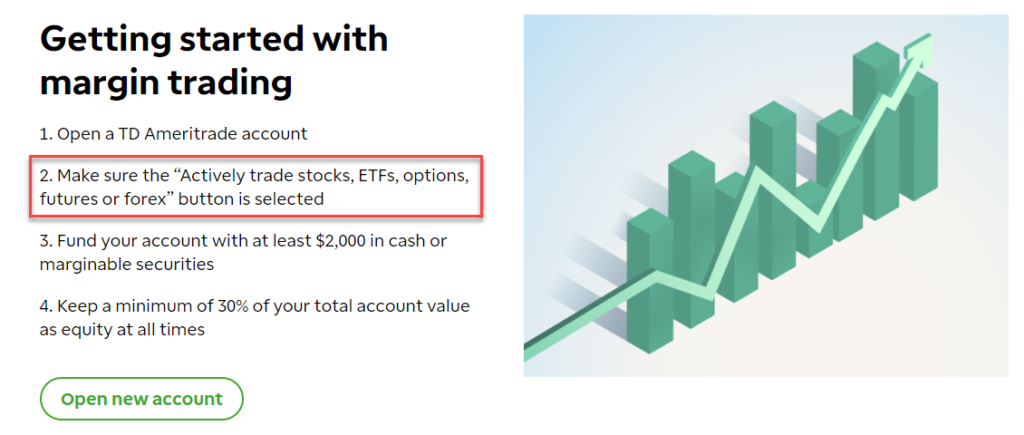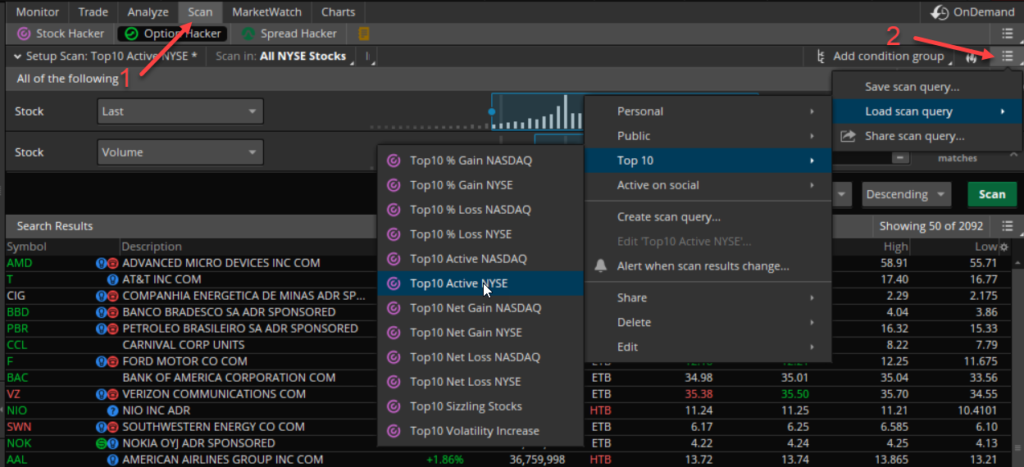In investing, sometimes there just aren’t that many good deals on stocks. The market gets overzealous about a company’s financial performance and prices shares at a premium. Or, the market is at the tail end of a multi-year bull run and stocks are just too expensive. As the saying goes, what goes up, must come down.
Investors can profit in this type of environment by shorting stocks. Most reputable brokerage firms, such as TD Ameritrade and Charles Schwab, allow individual investors to short stocks.
In this article, I’ll review how to short sell stocks on TD Ameritrade. But before I do that, let’s walk through the basics of short selling, why investors choose to do it, and some of the risks involved.
Please note – this article is intended for educational purposes only and is not formal investment advice.
Long vs short positions
In the stock market, there are 2 basic ways to make money. The first, and more traditional, is by opening up a long position. A long position is when an investor buys (to open) a stock at a lower price than they intend to sell it (to close). In other words, they hope the price of the stock goes up. For example, if an investor purchased a long position in Apple at a current price of $140, they’re hoping the share price goes to $150, leaving them with $10 in profit per share.
The second way to make money in the stock market, which new investors may be less familiar with, is when an investor opens up a short position. A short position is when an investor sells (to open) a stock they do not own in hopes they can buy it back (to close) at a lower price in the future. In a short sale, the investor profits when the stock price falls. For example, an investor could sell a share of AAPL at $140, then buy it back after the price dropped to $130, leaving them with $10 in profit per share.
Why individual investors short stocks
There are many reasons individual investors may choose to short sell stocks. 3 common reasons include:
- Valuation appears too high
- Rising interest rates
- Increased competition
Valuation appears too high
The price of a stock may appear too high based on common valuation methods such as price-to-earnings (P/E) ratios and discounted cashflow (DCF) analysis.
For example, a stock that normally trades at a P/E of 16 may see it’s P/E expand to 30 after a couple quarters of financial outperformance. This can happen when eager investors get excited about the company’s prospects and aggressively purchase shares. Strong demand for the stock sends shares higher, thereby expanding the P/E.
However, a skeptical investor who believes the company’s outperformance won’t last, and that the share price will eventually return to its historical P/E of 16, may decide to short the stock while it’s trading at a P/E of 30. As the balloon deflates, short sellers make money.
Rising interest rates
The Federal Reserve establishes interest rates on government debt which drives the value of the stock market. The United States government funds itself through the issuance of debt, also referred to as bonds or T-bills. Since it’s nearly impossible for the government to default on its debt (the US Treasury would just print more money), the interest bondholders receive by purchasing T-bills is essentially guaranteed.
If a 3-month T-bill is offering a 3% interest rate, a buyer of the T-bill is likely to make a 3% return on their investment, assuming they hold the T-bill to maturity (i.e. for 3 months). Upon maturity, the bondholder receives their initial investment plus 3% interest.
Stocks, on the other hand, don’t offer a guaranteed return. Therefore, investors expect a higher return potential by taking on additional risk. This is known as equity risk premium. Historically, the equity risk premium between the S&P 500 and 10YR Treasury Yield averages 3%.
So, if the 10YR yield is at 4%, the S&P 500 earnings yield should be somewhere near 7%. Earnings yield is calculated by taking the inverse of the P/E ratio. For example, if the S&P 500 P/E is 20, then its earnings yield is 5% (1 / 20 x 100).
As interest rates rise, equity risk premium adjusts to accommodate. If interest rates rise from 3% to 4%, the S&P 500 earnings yield may rise from 6% to 7% to maintain the 3% equity risk premium.
For the earnings yield to rise, the P/E must decline, which brings valuation along with it because a lower multiple is applied to earnings. This is why the stock market and interest rates tend to move in opposite direction of one another.
Increased competition
Lastly, another reason investors may choose to short a stock is due to increased competition in its industry. Blockbuster and Netflix are a good example. Investors who had the foresight to see Netflix was about to change how the world watches movies, could’ve shorted Blockbuster while going long Netflix back in the early 2000s. Investors who took this pair trade likely made millions because they profited both ways – while Netflix rose and while Blockbuster fell.
What is margin trading?
Trading on margin allows investors to borrow shares and borrow money to buy and sell “marginable” securities (stocks, exchange-traded funds, and commodities). It’s important to note not all stocks and ETFs are marginable. Nor can mutual funds be purchased on margin.
Borrowed shares
To short a stock, you need to borrow shares, via your brokerage account, from another shareholder. To participate in short selling, you’ll need to open a margin account. Don’t worry, getting approved is easy.
Borrowed money
A margin account also allows retail investors to borrow money from their brokerage firm via a margin loan. This may be attractive to some investors because it creates leverage, which increases purchasing power (i.e. you can purchase more shares with less of your money).
Leverage allows an investor to borrow up to 50% of the purchase price of the stock they’re looking to buy or sell. Of course, borrowed money isn’t typically free, and such is the case with margin loans (here’s a link to TD Ameritrade’s margin rates).
Here’s an example of margin trading from TD Ameritrade:
Let’s say you want to buy 1,000 shares of a stock that’s currently trading at $50 per share. If you bought it with only the cash in your account, you’d need $50,000. But if you bought the shares through a margin account, you’d only need to have $25,000 in your account to purchase them—the other $25,000 would be funded by margin.
If the stock rises from $50 to $55 per share (for a gain of $5 per share, or $5,000), you’d have a 20% profit, because the gain is based on the $25 per share paid with cash and excludes the $25 per share paid with funds borrowed from the broker.
But margin cuts both ways. If the stock dropped to $45 per share, you’d have a loss of 20%—double what the loss would be if you paid for the stock entirely in cash.
How to short a stock on TD Ameritrade
Step 1: Open a margin account
The first step to short selling stocks on TD Ameritrade is to open a margin account. To open a margin account, you need to fund your account with a minimum of $2,000 USD. It usually takes 2 to 3 business days to get approved after submitting the application.
Simply navigate to TD Ameritrade, click “Open new account”, and you’re on your way. Be sure the button is selected to “Actively trade stocks, ETFs, options, futures or forex.”

Step 2: Identify the stock or ETF you want to short
Finding good stocks to short can be just as difficult as finding good stocks to buy. If you don’t already have a stock in mind, I recommend using a stock screener. One option is to screen for stocks trading at extremely high P/E or price-to-sales (P/S) ratios. Another option might be to screen for stocks with a high debt-to-equity ratio and which have negative operating cashflow.
The options are almost endless, so be sure to make it your own.
Step 3: Determine if the stock or ETF is easy-to-borrow
As I mentioned above, not all stocks and ETFs are marginable. Some are easier to borrow than others. TD Ameritrade classifies stocks as easy-to-borrow (ETB), hard-to-borrow (HTB), and none-to-borrow (NTB). In my experience, only stocks and ETFs classified as ETB can be shorted at TD Ameritrade.
I recommend new and advanced traders alike download TD Ameritrade’s thinkorswim trading platform. It’s an excellent platform for technical analysis, trading tools, options trading, charting, and much more. It’s also the easiest way to determine if a stock or ETF is ETB. thinkorswim is available as a desktop platform, web platform, and via mobile app for on-the-go trading.
thinkorswim has pre-built scans which are easily customizable. “HTB/ETB” is one of the many attributes users are able to pull in.
For example, I can perform a scan on the Top 10 Active NYSE stocks.

Then modify the search results to pull in “HTB/ETB”.


All stocks listed as ETB can be shorted at TD Ameritrade.

Step 4: Place a “sell limit” order to open the position
Shorting a stock is unique in that you sell the stock prior to ever having purchased it. It’s a bit counterintuitive at first. Prior to jumping in with real money, I suggest experimenting in a paper trading account, which TD Ameritrade also offers via thinkorswim.
Selling shares on the open market (or market price) is usually not advisable because your order may get filled at a different price than expected. To sell-to-open a short position, your best bet is to set a “sell limit” order in which you specify the lowest price you’re willing to sell the stock.
For example, if TWTR is trading at $52 and you want to short it at $54 and no lower, you need to put in a “sell limit” order at $54. The order will only execute if the stock price reaches your limit of $54.
Here’s the thinkorswim order ticket to sell-to-open 10 shares of TWTR at $54.

Step 5: Set a “buy stop” order to protect the position
Stop orders are a defensive tactic to minimize losses should the trade go against you. In the case of short selling, the trade goes against you when the price of the stock goes up. To protect against this, consider setting a “buy stop” order at a predefined price above your sell price.
If you shorted TWTR at $54, a “buy stop” order at $57 will cap your losses at $3 per share. Be sure to set the order as good-until-closed (GTC) under “time in force.” This will ensure the order stays open until it’s filled or cancelled.
Here’s a proper “buy stop” order to buy-to-cover 10 shares of TWTR at a stop price of $57.

Step 6: Place a “buy limit” order to close the position
To close the short position at a specified price, place a “buy limit” order at the desired price and ensure “time in force” is set as GTC. As long as the stock price stays below the “buy stop” order and above the “buy limit” order, you will remain in the trade. If you’re fortunate enough to have the trade go in your favor and trigger the “buy limit” order, you will have closed the position with a profit.
Here’s a proper “buy limit” order to buy-to-cover 10 shares of TWTR at a limit price of $40. If triggered, this order would close the short position with $14 per share in profit.

Altogether, the open orders look like this on the chart.

Risks of short selling
Short selling a stock is not without its risks, especially if shorting on margin. Yes, trading on margin has the potential to increase your profits, but it also has the potential to increase your losses.
TD Ameritrade lists the following as risks associated with short selling:
- Unlimited risk. Because there is technically no limit to how high a stock or ETF price can rise, your risk of loss in short selling is unlimited.
- Dividends and other payments. You’re responsible for any dividends, stock splits, or spin-offs paid on the borrowed stock.
- Unfavorable liquidation. You may be required to close your short positions at unfavorable prices, particularly in cases where your stock experiences a sharp surge in price.
- Historical upward trend. Historically, the broader stock market has risen over time. Though past performance is no guarantee of future results, the market’s tendency to rise over time remains a potential risk for any short seller.
Build an educational foundation
For beginner investors, I don’t recommend shorting stocks on TD Ameritrade without a strong understanding of order types, margin requirements, and a lot of practice in a paper trading account. Investors should also understand maintenance requirements associated with their margin account as well as margin calls.
If shorting stocks on margin, you’ll also want to understand how interest is accrued on dollars borrowed and how its debited from your account.
Shorting a stock is typically reserved for advanced investors who have a high risk tolerance. A familiarity of fundamental and technical analysis may also prove beneficial in helping to identify short ideas.
For the average long-term investor like myself, you’ll likely do just fine sticking to the old time-tested strategy of buying low and selling high.
